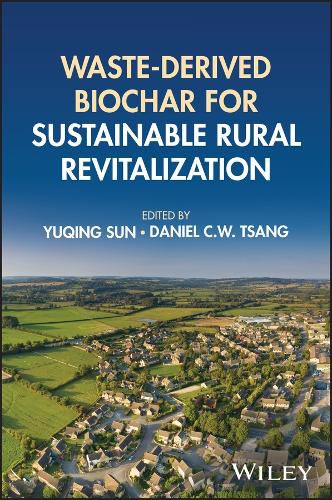Readings Newsletter
Become a Readings Member to make your shopping experience even easier.
Sign in or sign up for free!
You’re not far away from qualifying for FREE standard shipping within Australia
You’ve qualified for FREE standard shipping within Australia
The cart is loading…






Comprehensive reference summarizing different technologies for application-oriented biochar production from waste biomass resources in rural areas
Waste-derived Biochar for Sustainable Rural Revitalization summarizes recent research developments, introduces state-of-the-art knowledge, incorporates case studies, offers scientific insights, highlights current challenges, and shows the way forward for biochar technologies as a novel, cost-effective, and environmentally friendly solution for sustainable rural revitalization. This book succinctly summarizes different technologies for application-oriented biochar production from waste biomass resources (e.g., crop residues, pruning of fruit trees, animal waste, food waste, and domestic sludge) in rural areas, with an emphasis on tailored selection of pyrolytic and pre/post-treatment conditions.
Readers will find information on renewable biofuels, clean compost conditioner, organic seeding substrate, slow-release fertilizers, green pesticides, targeting plant disease suppressors, farmland soil conditioner/amendment, adsorbent/catalyst for agriculture wastewater treatment, farmland carbon sequestration, and low-carbon construction materials. This book also evaluates these technologies through Technical and Economic Analysis (TEA) and Environmental, Social, and Governance (ESG) frameworks and discusses potential environmental risks.
Written by a team of highly qualified authors, Waste-derived Biochar for Sustainable Rural Revitalization explores sample topics including:
Slow, fast, microwave, and flash pyrolysis, physical and chemical modification of biochars, and commonly used biochar raw materials Technologies and key influencing factors in biochar preparation, types and characteristics of carbonation reactors, and migration of alkali metals during biochar combustion Waste-derived biochar as organic seeding substrate, discussing the growing media of compost, humic acid, and activated carbon Improvement of soil physical, chemical, and biological properties by waste-derived biochar, covering effects on soil pH, organic matter, and cation exchange quantity
Waste-derived Biochar for Sustainable Rural Revitalization serves as an invaluable reference for engineers, scientists, researchers, and graduate students in waste recycling and management, sustainable rural development, environmental engineering, civil engineering, chemical engineering, and related fields.
$9.00 standard shipping within Australia
FREE standard shipping within Australia for orders over $100.00
Express & International shipping calculated at checkout
Stock availability can be subject to change without notice. We recommend calling the shop or contacting our online team to check availability of low stock items. Please see our Shopping Online page for more details.
Comprehensive reference summarizing different technologies for application-oriented biochar production from waste biomass resources in rural areas
Waste-derived Biochar for Sustainable Rural Revitalization summarizes recent research developments, introduces state-of-the-art knowledge, incorporates case studies, offers scientific insights, highlights current challenges, and shows the way forward for biochar technologies as a novel, cost-effective, and environmentally friendly solution for sustainable rural revitalization. This book succinctly summarizes different technologies for application-oriented biochar production from waste biomass resources (e.g., crop residues, pruning of fruit trees, animal waste, food waste, and domestic sludge) in rural areas, with an emphasis on tailored selection of pyrolytic and pre/post-treatment conditions.
Readers will find information on renewable biofuels, clean compost conditioner, organic seeding substrate, slow-release fertilizers, green pesticides, targeting plant disease suppressors, farmland soil conditioner/amendment, adsorbent/catalyst for agriculture wastewater treatment, farmland carbon sequestration, and low-carbon construction materials. This book also evaluates these technologies through Technical and Economic Analysis (TEA) and Environmental, Social, and Governance (ESG) frameworks and discusses potential environmental risks.
Written by a team of highly qualified authors, Waste-derived Biochar for Sustainable Rural Revitalization explores sample topics including:
Slow, fast, microwave, and flash pyrolysis, physical and chemical modification of biochars, and commonly used biochar raw materials Technologies and key influencing factors in biochar preparation, types and characteristics of carbonation reactors, and migration of alkali metals during biochar combustion Waste-derived biochar as organic seeding substrate, discussing the growing media of compost, humic acid, and activated carbon Improvement of soil physical, chemical, and biological properties by waste-derived biochar, covering effects on soil pH, organic matter, and cation exchange quantity
Waste-derived Biochar for Sustainable Rural Revitalization serves as an invaluable reference for engineers, scientists, researchers, and graduate students in waste recycling and management, sustainable rural development, environmental engineering, civil engineering, chemical engineering, and related fields.